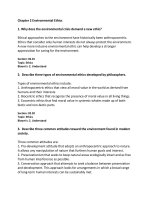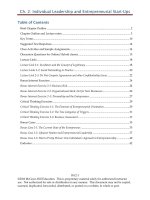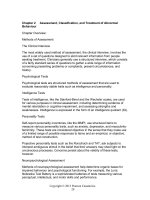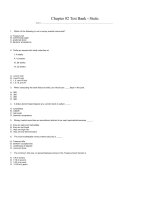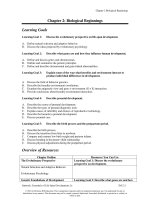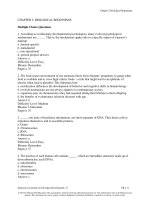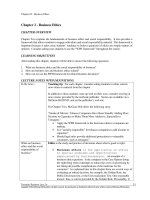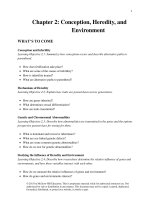Test bank and solution manual of CH02 biological beginning (2)
Bạn đang xem bản rút gọn của tài liệu. Xem và tải ngay bản đầy đủ của tài liệu tại đây (234.31 KB, 35 trang )
Chapter 2 Biological Beginnings
CHAPTER 2: BIOLOGICAL BEGINNINGS
Multiple Choice Questions
1. According to evolutionary developmental psychologists, many evolved psychological
mechanisms are _____. That is, the mechanisms apply only to a specific aspect of a person’s
makeup.
a. domain-specific
b. maladjusted
c. non-operational
d. general purpose devices
Answer: a
Difficulty Level: Easy
Blooms: Remember
Page(s): 35
2. The food-scarce environment of our ancestors likely led to humans’ propensity to gorge when
food is available and to crave high-caloric foods—a trait that might lead to an epidemic of
obesity when food is plentiful. This illustrates how:
a. socialization influences the development of behavior and cognitive skills in human beings.
b. evolved mechanisms are not always adaptive in contemporary society.
c. organisms pass on characteristics they had acquired during their lifetime to their offspring.
d. the benefits of evolutionary selection decrease with age.
Answer: b
Difficulty Level: Medium
Blooms: Understand
Page(s): 35
3. _____, the units of hereditary information, are short segments of DNA. They direct cells to
reproduce themselves and to assemble proteins.
a. Genes
b. Chromosomes
c. RNA
d. Ribosomes
Answer: a
Difficulty Level: Easy
Blooms: Remember
Page(s): 37
4. The nucleus of each human cell contains _____, which are threadlike structures made up of
deoxyribonucleic acid (DNA).
a. mitochondria
b. ribosomes
c. chromosomes
d. mesosomes
Answer: c
Santrock, Essentials of Life-Span Development, 3e
TB-2 | 1
© 2014 by McGraw-Hill Education. This is proprietary material solely for authorized instructor use. Not authorized for sale or distribution in any
manner. This document may not be copied, scanned, duplicated, forwarded, distributed, or posted on a website, in whole or part.
Chapter 2 Biological Beginnings
Difficulty Level: Easy
Blooms: Remember
Page(s): 37
5. _____ are the building blocks of cells as well as the regulators that direct the body’s processes.
a. Genes
b. Proteins
c. Ribosomes
d. DNA
Answer: b
Difficulty Level: Easy
Blooms: Remember
Page(s): 37
6. Which of the following statements about the activity of genes is true?
a. Genes are not collaborative.
b. A single gene codes for a single, specific protein.
c. Genetic expression is unaffected by environmental factors.
d. Events inside of the cell can excite or inhibit genetic expression.
Answer: d
Difficulty Level: Medium
Blooms: Understand
Page(s): 38
7. _____ is a stage in reproduction whereby an egg and a sperm fuse to create a single cell.
a. Fertilization
b. Osmosis
c. Meiosis
d. Mitosis
Answer: a
Difficulty Level: Easy
Blooms: Remember
Page(s): 38
8. During the process of _____, the cell’s nucleus—including the chromosomes—duplicates
itself and the cell divides resulting in the formation of two cells.
a. meiosis
b. osmosis
c. fertilization
d. mitosis
Answer: d
Difficulty Level: Easy
Blooms: Remember
Page(s): 38
9. Which of the following is true of mitosis in humans?
Santrock, Essentials of Life-Span Development, 3e
TB-2 | 2
© 2014 by McGraw-Hill Education. This is proprietary material solely for authorized instructor use. Not authorized for sale or distribution in any
manner. This document may not be copied, scanned, duplicated, forwarded, distributed, or posted on a website, in whole or part.
Chapter 2 Biological Beginnings
a. Mitosis is the cellular reproduction occurs in the sperm and egg cells.
b. Mitosis results in the formation of four new cells.
c. Mitocis results in the formation of new cells with 23 pairs of chromosomes.
d. Mitosis results in the formation of three new cells.
Answer: c
Difficulty Level: Medium
Blooms: Understand
Page(s): 38
10. A cell which contains 12 pairs of chromosomes, divides by mitosis to form two new cells.
How many pairs of chromosomes does each new cell contain?
a. 12
b. 23
c. 6
d. 48
Answer: a
Difficulty Level: Hard
Blooms: Apply
Page(s): 38
11. During _____, a cell of the testes in men or ovaries in women duplicates its chromosomes
and then divides twice, thus forming four cells, each of which has only half the genetic material
of the parent cell.
a. meiosis
b. mitosis
c. osmosis
d. fertilization
Answer: a
Difficulty Level: Easy
Blooms: Remember
Page(s): 38
12. In human beings, by the end of meiosis, each egg or sperm has _____ chromosomes.
a. 46 paired
b. 23 unpaired
c. 23 paired
d. 46 unpaired
Answer: b
Difficulty Level: Easy
Blooms: Remember
Page(s): 38
13. During fertilization, an egg and a sperm fuse to create a single cell called a _____.
a. blastocyst
b. fetus
c. gamete
Santrock, Essentials of Life-Span Development, 3e
TB-2 | 3
© 2014 by McGraw-Hill Education. This is proprietary material solely for authorized instructor use. Not authorized for sale or distribution in any
manner. This document may not be copied, scanned, duplicated, forwarded, distributed, or posted on a website, in whole or part.
Chapter 2 Biological Beginnings
d. zygote
Answer: d
Difficulty Level: Easy
Blooms: Remember
Page(s): 38
14. A mistake by the cellular machinery, or damage from an environmental agent such as
radiation, may produce a _____, which is a permanently altered segment of DNA.
a. susceptibility gene
b. vulnerability gene
c. longevity gene
d. mutated gene
Answer: d
Difficulty Level: Easy
Blooms: Remember
Page(s): 39
15. _____ genes are those that make the individual more vulnerable to specific diseases or
acceleration of aging.
a. Susceptibility
b. Longevity
c. Vulnerability
d. Mutated
Answer: a
Difficulty Level: Easy
Blooms: Remember
Page(s): 39
16. Ethel is 50-years-old but appears much more aged in appearance. Most of Ethel’s relatives
don’t live past the age of 60. Which of the following genes are responsible for the accelerated
aging that is observed in Ethel and her family members?
a. Susceptibility genes
b. Longevity genes
c. Vulnerability genes
d. Mutated genes
Answer: a
Difficulty Level: Hard
Blooms: Apply
Page(s): 39
17. _____ genes are those that make the individual less vulnerable to certain diseases and be
more likely to live to an older age.
a. Susceptibility
b. Longevity
c. Vulnerability
d. Mutated
Santrock, Essentials of Life-Span Development, 3e
TB-2 | 4
© 2014 by McGraw-Hill Education. This is proprietary material solely for authorized instructor use. Not authorized for sale or distribution in any
manner. This document may not be copied, scanned, duplicated, forwarded, distributed, or posted on a website, in whole or part.
Chapter 2 Biological Beginnings
Answer: b
Difficulty Level: Easy
Blooms: Remember
Page(s): 39
18. Erin is 90 years old. She has relatively good health, and is fully mobile. Most of Erin’s blood
relatives to live to a ripe, old age. Which of the following genes might be responsible for this?
a. Susceptibility genes
b. Longevity genes
c. Vulnerability genes
d. Mutated genes
Answer: b
Difficulty Level: Hard
Blooms: Apply
Page(s): 39
19. Emma and Anna are identical twins who were adopted by different families a few weeks
after birth. Although genetically identical, they grew up with different physical and
psychological characteristics. For example, though both inherited a tendency to grow large, Anna
was slim and athletic due to the active lifestyle practiced in her adoptive family. This variability
can be explained by how:
a. each zygote is unique.
b. longevity genes can make an individual less vulnerable to certain diseases.
c. for each genotype, a range of phenotypes can be expressed .
d. mutated genes can be a source of genetic variability.
Answer: c
Difficulty Level: Hard
Blooms: Apply
Page(s): 39-40
20. _____ is the way an individual’s genotype is expressed in observable and measurable
characteristics.
a. RNA
b. DNA
c. Phenotype
d. Stereotype
Answer: c
Difficulty Level: Easy
Blooms: Remember
Page(s): 39
21. Marly describes her friend, Gina, as having blonde hair, green eyes, and fair skin with
freckles. Marly has described Gina’s _____.
a. genotype
b. genetic imprint
c. phenotype
Santrock, Essentials of Life-Span Development, 3e
TB-2 | 5
© 2014 by McGraw-Hill Education. This is proprietary material solely for authorized instructor use. Not authorized for sale or distribution in any
manner. This document may not be copied, scanned, duplicated, forwarded, distributed, or posted on a website, in whole or part.
Chapter 2 Biological Beginnings
d. X-linked inheritance
Answer: c
Difficulty Level: Medium
Blooms: Apply
Page (s): 39
22. In some cases, one gene of a pair always exerts its effects, overriding the potential influence
of the other gene. This is the _____ principle.
a. sex-linked genes
b. dominant-recessive genes
c. genetic imprinting
d. polygenic inheritance
Answer: b
Difficulty Level: Easy
Blooms: Remember
Page(s): 40
23. Clark’s genotype contains a dominant gene for brown eye color and recessive gene for blue
eye color. According to the dominant-recessive gene principle, which of the following
phenotypes is most likely to be observed in Clark?
a. black eyes
b. blue eyes
c. grey eyes
d. brown eyes
Answer: d
Difficulty Level: Hard
Blooms: Apply
Page(s): 40
24. Mary’s mother has blonde hair and her father has brown hair. Mary has a gene for brown hair
and a gene for blonde hair. She has brown hair. This indicates that the gene for brown hair is a(n)
_____.
a. dominant gene
b. recessive gene
c. susceptible gene
d. longevity gene
Answer: a
Difficulty Level: Hard
Blooms: Apply
Page(s): 40
25. Carrie’s parents both have brown hair. However, Carrie gets genes for blond hair from both
parents, and as result she has blonde hair. This indicates that the gene for blonde hair is a(n):
a. recessive gene.
b. dominant gene.
c. susceptibility gene.
Santrock, Essentials of Life-Span Development, 3e
TB-2 | 6
© 2014 by McGraw-Hill Education. This is proprietary material solely for authorized instructor use. Not authorized for sale or distribution in any
manner. This document may not be copied, scanned, duplicated, forwarded, distributed, or posted on a website, in whole or part.
Chapter 2 Biological Beginnings
d. longevity gene.
Answer: a
Difficulty Level: Hard
Blooms: Apply
Page(s): 40
26. A recessive gene exerts its influence only if:
a. both genes in a pair are recessive.
b. it is the stronger gene.
c. the environment is right.
d. the dominant gene is also present in the pair.
Answer: a
Difficulty Level: Easy
Blooms: Remember
Page(s): 40
27. Which of the following is an example of chromosomal abnormality that occurs when whole
chromosomes do not separate properly during meiosis?
a. Down syndrome
b. Hemophilia
c. Huntington’s disease
d. Sickle-cell anemia
Answer: a
Difficulty Level: Medium
Blooms: Understand
Page(s): 41
28. Jason was born with _____. The doctor tells his parents that this genetic disorder occurred
because he has an extra copy of chromosome 21.
a. fragile X syndrome
b. Klinefelter disease
c. Down syndrome
d. Tay Sach’s disease
Answer: c
Difficulty Level: Medium
Blooms: Apply
Page(s): 41
29. Which of the following is true of Down syndrome?
a. It primarily occurs in African American children.
b. It occurs when genetic imprinting goes awry.
c. Its symptoms include retardation of motor and mental abilities.
d. It is caused by the presence of an extra copy of chromosome Y.
Answer: c
Difficulty Level: Medium
Blooms: Understand
Santrock, Essentials of Life-Span Development, 3e
TB-2 | 7
© 2014 by McGraw-Hill Education. This is proprietary material solely for authorized instructor use. Not authorized for sale or distribution in any
manner. This document may not be copied, scanned, duplicated, forwarded, distributed, or posted on a website, in whole or part.
Chapter 2 Biological Beginnings
Page(s): 41
30. Which of the following women has the highest probability of giving birth to a child with
Down syndrome?
a. Sarah, a 21-year-old Asian woman
b. Jane, a 41-year-old Euro-American woman
c. Ella, a 27-year-old African American woman
d. Destiny, a 38-year-old African American woman
Answer: b
Difficulty Level: Hard
Blooms: Apply
Page(s): 42
31. Klinefelter syndrome affects:
a. only males.
b. only females.
c. both males and females equally.
d. more females than males.
Answer: a
Difficulty Level: Easy
Blooms: Remember
Page(s): 42
32. Tristan has a genetic disorder that results from an abnormality in the X chromosome, which
becomes constricted and often breaks. His doctor told Tristan’s mother that he has:
a. Fragile X syndrome.
b. XYY syndrome.
c. Turner syndrome.
d. Tay-Sach’s disease.
Answer: a
Difficulty Level: Medium
Blooms: Apply
Page(s): 42
33. Angelique has a chromosomal disorder characterized by a missing X chromosome making
her XO instead of XX. Angelique’s doctors have diagnosed her with _____.
a. Fragile X syndrome
b. The XYY syndrome
c. Klinefelter syndrome
d. Turner syndrome
Answer: d
Difficulty Level: Medium
Blooms: Apply
Page(s): 42
34. Turner syndrome occurs exclusively in:
Santrock, Essentials of Life-Span Development, 3e
TB-2 | 8
© 2014 by McGraw-Hill Education. This is proprietary material solely for authorized instructor use. Not authorized for sale or distribution in any
manner. This document may not be copied, scanned, duplicated, forwarded, distributed, or posted on a website, in whole or part.
Chapter 2 Biological Beginnings
a. females.
b. males.
c. people of Middle Eastern descent.
d. people of Jewish descent.
Answer: a
Difficulty Level: Easy
Blooms: Remember
Page(s): 42
35. Which of the following is true of phenylketonuria?
a. It results from a recessive gene.
b. It is a chromosomal disorder.
c. It results in death by 5 years of age.
d. It is caused by an accumulation of lipids in the nervous system.
Answer: a
Difficulty Level: Medium
Blooms: Understand
Page(s): 42
36. Which of the following is a gene-linked abnormality?
a. Down syndrome.
b. Phenylketonuria (PKU).
c. Turner syndrome
d. Klinefelter syndrome
Answer: b
Difficulty Level: Medium
Blooms: Understand
Page(s): 42
37. Tamera has a genetic disorder where her red blood cells take on a hook shape instead of the
normal disk shape. The doctors tell Tamera’s parents that she has _____, and that this condition
also provides her with a resistance to malaria.
a. Tay-Sach’s disease
b. sickle-cell anemia
c. leukemia
d. Huntington’s disease
Answer: b
Difficulty Level: Medium
Blooms: Apply
Page(s): 43
38. Paul suffers from hemophilia. Suggest an appropriate treatment option for Paul’s condition.
a. Insulin
b. Blood transfusions/injections
c. Physical therapy
d. Corrective surgery at birth
Santrock, Essentials of Life-Span Development, 3e
TB-2 | 9
© 2014 by McGraw-Hill Education. This is proprietary material solely for authorized instructor use. Not authorized for sale or distribution in any
manner. This document may not be copied, scanned, duplicated, forwarded, distributed, or posted on a website, in whole or part.
Chapter 2 Biological Beginnings
Answer: b
Difficulty Level: Medium
Blooms: Apply
Page(s): 43
39. Samantha has been diagnosed with _____, which is a glandular dysfunction that interferes
with mucus production.
a. cystic fibrosis
b. Huntington’s disease
c. PKU
d. Tay-Sachs disease
Answer: a
Difficulty Level: Medium
Blooms: Apply
Page(s): 43
40. Mary and Jim are expecting a child and prenatal diagnostic procedures have confirmed that
the fetus has _____, a neural tube disorder that causes brain and spine abnormalities. Their
physician has explained that this gene-linked abnormality could be treated with corrective
surgery at birth, orthopedic devices, and physical or medical therapy.
a. spina bifida
b. Tay-Sachs disease
c. PKU
d. Huntington’s disease
Answer: a
Difficulty Level: Medium
Blooms: Apply
Page(s): 43
41. Lindsay’s body does not produce enough insulin, causing an abnormal metabolism of sugar.
She is receiving insulin treatment. Lindsay has:
a. spina bifida.
b. hemophilia.
c. PKU.
d. diabetes.
Answer: d
Difficulty Level: Medium
Blooms: Apply
Page(s): 43
42. Joshua, 2, has been diagnosed with _____, a blood disorder that limits the body’s oxygen
supply and can cause joint swelling and heart and kidney failure. This genetic disorder can be
treated through penicillin, pain medication, antibiotics and blood transfusions, and his doctor has
indicated that a study named Baby HUG may offer a better drug in the future.
a. spina bifida
b. Tay-Sachs disease
Santrock, Essentials of Life-Span Development, 3e
TB-2 | 10
© 2014 by McGraw-Hill Education. This is proprietary material solely for authorized instructor use. Not authorized for sale or distribution in any
manner. This document may not be copied, scanned, duplicated, forwarded, distributed, or posted on a website, in whole or part.
Chapter 2 Biological Beginnings
c. sickle-cell anemia
d. Huntington’s disease
Answer: c
Difficulty Level: Medium
Blooms: Apply
Page(s): 43
43. Benny has been diagnosed with a gene-linked abnormality characterized by deceleration of
mental and physical development caused by an accumulation of lipids in the nervous system. He
has been put on medication and a special diet, but his family has been told that he will probably
not live beyond the age of five. Benny is suffering from:
a. spina bifida.
b. Tay-Sachs disease.
c. phenylketonuria.
d. Huntington’s disease.
Answer: b
Difficulty Level: Medium
Blooms: Apply
Page (s): 43
44. _____ is the field that seeks to discover the influence of heredity and environment on
individual differences in human traits and development.
a. Behavior influence
b. Behavior therapy
c. Behavior genetics
d. Behavior development
Answer: c
Difficulty Level: Easy
Blooms: Remember
Page(s): 44
45. Rachel loves to read books and also encourages her daughter to read by regularly taking her
to the local library and buying her lots of books. Rachel’s daughter is now an avid reader. This
reflects a _____ correlation.
a. passive genotype-environment
b. evocative genotype–environment
c. influential genotype–environment
d. active (niche-picking) genotype–environment
Answer: a
Difficulty Level: Medium
Blooms: Apply
Page(s): 45
46. Tracy’s parents are avid sports fans. Since she was a child, they took her to numerous
baseball and football games, and Tracy regularly watched the sports channel with her dad. When
Santrock, Essentials of Life-Span Development, 3e
TB-2 | 11
© 2014 by McGraw-Hill Education. This is proprietary material solely for authorized instructor use. Not authorized for sale or distribution in any
manner. This document may not be copied, scanned, duplicated, forwarded, distributed, or posted on a website, in whole or part.
Chapter 2 Biological Beginnings
she was old enough, her parents made her join the little league team at her school and she
performed well. This is an example of a(n):
a. evocative genotype–environment correlation.
b. active (niche-picking) genotype–environment correlation.
c. passive genotype-environment correlation.
d. gene-gene correlation.
Answer: c
Difficulty Level: Medium
Blooms: Apply
Page(s): 45
47. _____ correlations occur because a child’s genetically influenced characteristics elicit certain
types of environments.
a. Passive genotype–environment
b. Evocative genotype-environment
c. Influential genotype–environment
d. Active (niche-picking) genotype–environment
Answer: b
Difficulty Level: Easy
Blooms: Remember
Page(s): 45
48. Charlie is a cooperative, attentive child and is a favorite at home and school and receives
positive, instructive responses from adults. This is indicative of a(n):
a. passive genotype–environment correlation.
b. evocative genotype-environment correlation.
c. influential genotype–environment correlation.
d. active (niche-picking) genotype–environment correlation.
Answer: b
Difficulty Level: Medium
Blooms: Apply
Page(s): 45
49. Timothy is a quiet 6-year-old who is usually withdrawn in class. As a result, he does not
receive much attention from his peers and mostly plays by himself. According to Sandra Scarr,
this is an example of a(n) _____.
a. passive genotype–environment correlation
b. active (niche-picking) genotype–environment correlation
c. gene x environment interaction
d. evocative genotype-environment correlation
Answer: d
Difficulty Level: Medium
Blooms: Apply
Page(s): 45
Santrock, Essentials of Life-Span Development, 3e
TB-2 | 12
© 2014 by McGraw-Hill Education. This is proprietary material solely for authorized instructor use. Not authorized for sale or distribution in any
manner. This document may not be copied, scanned, duplicated, forwarded, distributed, or posted on a website, in whole or part.
Chapter 2 Biological Beginnings
50. Brad is an athletic boy who is on every sport team in school. Stephen loves math and is part
of his school’s math club. These instances reflect _____ correlations that occur when children
seek out environments that they find compatible and stimulating.
a. passive genotype–environment
b. evocative genotype–environment
c. active (niche-picking) genotype-environment
d. influential genotype–environment
Answer: c
Difficulty Level: Medium
Blooms: Apply
Page(s): 45
51. Which of the following is an example of a passive genotype-environment correlation?
a. Uncooperative, distractible children receive more unpleasant and disciplinary action from
parents and teachers.
b. Outgoing children tend to seek out social contexts in which to interact with people.
c. Parents who have a genetic predisposition to be musically inclined encourage their children to
learn how to play a music instrument.
d. Infants who smile more receive more attention from individuals in their social environment.
Answer: c
Difficulty Level: Medium
Blooms: Understand
Page(s): 45
52. The _____ view states that development is the result of an ongoing, bidirectional interchange
between heredity and the environment.
a. epigenetic
b. biosocial
c. sociogenetic
d. congenital
Answer: a
Difficulty Level: Easy
Blooms: Remember
Page(s): 46
53. _____ is the interaction of a specific measured variation in the DNA and a specific measured
aspect of the environment.
a. Heredity-environment correlation
b. Evocative genotype-environment correlation
c. Gene × environment (G × E) interaction
d. Passive genotype-environment interaction
Answer: c
Difficulty Level: Easy
Blooms: Remember
Page(s): 47
Santrock, Essentials of Life-Span Development, 3e
TB-2 | 13
© 2014 by McGraw-Hill Education. This is proprietary material solely for authorized instructor use. Not authorized for sale or distribution in any
manner. This document may not be copied, scanned, duplicated, forwarded, distributed, or posted on a website, in whole or part.
Chapter 2 Biological Beginnings
54. Prenatal development can be divided into three periods, which of the following is in the
correct order from conception to birth?
a. Fertile; embryonic; postterm
b. Preterm; germinal; postterm
c. Gestational; germinal; postnatal
d. Germinal; embryonic; fetal
Answer: d
Difficulty Level: Easy
Blooms: Remember
Page(s): 48
55. Rachel is in the first period of prenatal development. Even though she doesn’t know it, she is
in the _____ stage of prenatal development.
a. fetal period
b. embryonic period
c. implantation period
d. germinal period
Answer: d
Difficulty Level: Medium
Blooms: Apply
Page(s): 48
56. The creation of the fertilized egg takes place in the _____ period of prenatal development.
a. fetal
b. embryonic
c. implantation
d. germinal
Answer: d
Difficulty Level: Easy
Blooms: Remember
Page(s): 48
57. _____ refers to the attachment of the blastocyst to the uterine wall.
a. Implantation
b. Conception
c. Fertilization
d. Involution
Answer: a
Difficulty Level: Easy
Blooms: Remember
Page(s): 48
58. The _____ is the outer layer of cells of the blastocyst that later provides nutrition and support
for the embryo.
a. ectoderm
b. perineum
Santrock, Essentials of Life-Span Development, 3e
TB-2 | 14
© 2014 by McGraw-Hill Education. This is proprietary material solely for authorized instructor use. Not authorized for sale or distribution in any
manner. This document may not be copied, scanned, duplicated, forwarded, distributed, or posted on a website, in whole or part.
Chapter 2 Biological Beginnings
c. cytocyst
d. trophoblast
Answer: d
Difficulty Level: Easy
Blooms: Remember
Page(s): 48
59. Which of the following is a feature of the embryonic period of prenatal development?
a. The creation of the fertilized egg
b. Formation of the blastocyst
c. The attachment of the zygote to the uterine wall
d. Formation of support systems for cells
Answer: d
Difficulty Level: Medium
Blooms: Understand
Page(s): 48
60. Wren is 4 weeks pregnant. Which of the following stages of prenatal development is Wren
currently in?
a. Embryonic
b. Fetal
c. Placental
d. Germinal
Answer: a
Difficulty Level: Medium
Blooms: Apply
Page(s): 48
61. The _____ consists of three layers of cells: the endoderm, the mesoderm, and the ectoderm.
a. blastocyst
b. fetus
c. embryo
d. trophoblast
Answer: c
Difficulty Level: Easy
Blooms: Remember
Page(s): 49
62. The inner layer of cells of the embryo is referred to as the:
a. mesoderm.
b. epidermis.
c. endometrium.
d. endoderm.
Answer: d
Difficulty Level: Easy
Blooms: Remember
Santrock, Essentials of Life-Span Development, 3e
TB-2 | 15
© 2014 by McGraw-Hill Education. This is proprietary material solely for authorized instructor use. Not authorized for sale or distribution in any
manner. This document may not be copied, scanned, duplicated, forwarded, distributed, or posted on a website, in whole or part.
Chapter 2 Biological Beginnings
Page(s): 49
63. The embryo’s _____ develops into the digestive and respiratory systems.
a. ectoderm
b. endoderm
c. trophoblast
d. mesoderm
Answer: b
Difficulty Level: Easy
Blooms: Remember
Page(s): 49
64. The outermost layer of the embryo is called the _____.
a. mesoderm
b. cytoderm
c. endoderm
d. ectoderm
Answer: d
Difficulty Level: Easy
Blooms: Remember
Page(s): 49
65. The middle layer of the embryo is called the _____.
a. mesoderm
b. cytoderm
c. endoderm
d. ectoderm
Answer: a
Difficulty Level: Easy
Blooms: Remember
Page(s): 49
66. The _____ is a layer of the embryo, which will become the circulatory system, bones,
muscles, excretory system, and reproductive system.
a. endoderm
b. ectoderm
c. mesoderm
d. epidermis
Answer: c
Difficulty Level: Easy
Blooms: Remember
Page(s): 49
67. The _____ is a layer of the embryo, which will become the nervous system and brain,
sensory receptors, and skin parts.
a. mesoderm
Santrock, Essentials of Life-Span Development, 3e
TB-2 | 16
© 2014 by McGraw-Hill Education. This is proprietary material solely for authorized instructor use. Not authorized for sale or distribution in any
manner. This document may not be copied, scanned, duplicated, forwarded, distributed, or posted on a website, in whole or part.
Chapter 2 Biological Beginnings
b. ectoderm
c. trophoblast
d. endoderm
Answer: b
Difficulty Level: Easy
Blooms: Remember
Page(s): 49
68. A group of tissues in which small blood vessels from the mother and offspring intertwine but
do not connect is the _____.
a. amnion
b. placenta
c. embryo
d. umbilical cord
Answer: b
Difficulty Level: Easy
Blooms: Remember
Page(s): 49
69. The structure that contains two arteries and one vein, and connects the developing embryo to
the mother’s body, is called the _____.
a. amnion
b. placenta
c. embryo
d. umbilical cord
Answer: d
Difficulty Level: Easy
Blooms: Remember
Page(s): 49
70. The _____ prevents large molecules like red blood cells and harmful substances, such as
most bacteria and maternal wastes, from entering the fetus.
a. umbilical cord
b. placental wall
c. amniotic sheath
d. ectoderm
Answer: b
Difficulty Level: Easy
Blooms: Remember
Page(s): 49
71. The _____ is like a bag or an envelope and contains a clear fluid in which the developing
embryo floats.
a. placenta
b. umbilical cord
c. amnion
Santrock, Essentials of Life-Span Development, 3e
TB-2 | 17
© 2014 by McGraw-Hill Education. This is proprietary material solely for authorized instructor use. Not authorized for sale or distribution in any
manner. This document may not be copied, scanned, duplicated, forwarded, distributed, or posted on a website, in whole or part.
Chapter 2 Biological Beginnings
d. cervix
Answer: c
Difficulty Level: Easy
Blooms: Remember
Page(s): 49
72. The _____ provides an environment that is temperature and humidity controlled, as well as
shockproof.
a. placental wall
b. pericardial fluid
c. umbilical cord
d. amniotic fluid
Answer: d
Difficulty Level: Easy
Blooms: Remember
Page(s): 49
73. Which of the following is a small molecule that would be able to pass through the placental
wall?
a. Red blood cells
b. Carbon dioxide
c. Hormones
d. Maternal wastes
Answer: b
Difficulty Level: Hard
Blooms: Understand
Page(s): 49
74. Which of the following substances is a large molecule that would NOT be able to pass
through the placental wall?
a. Salt
b. Water
c. Hormones
d. Carbon dioxide
Answer: c
Difficulty Level: Hard
Blooms: Understand
Page(s): 49
75. Petra is at the fourth month of her pregnancy. Her unborn child is now referred to as a _____.
a. gamete
b. zygote
c. fetus
d. embryo
Answer: c
Difficulty Level: Medium
Santrock, Essentials of Life-Span Development, 3e
TB-2 | 18
© 2014 by McGraw-Hill Education. This is proprietary material solely for authorized instructor use. Not authorized for sale or distribution in any
manner. This document may not be copied, scanned, duplicated, forwarded, distributed, or posted on a website, in whole or part.
Chapter 2 Biological Beginnings
Blooms: Apply
Page(s): 49
76. The fetus that Calista is carrying has reached the age of viability, meaning that it has a
chance of surviving outside of the womb. Therefore, it can be inferred that Calista is _____
weeks pregnant.
a. 4 to 8
b. 16 to 18
c. 24 to 25
d. 10 to 12
Answer: c
Difficulty Level: Hard
Blooms: Apply
Page(s): 50
77. Which of the following organs or systems develop FIRST in prenatal development?
a. Visual system
b. Spinal cord
c. Urogenital system
d. Liver
Answer: b
Difficulty Level: Hard
Blooms: Understand
Page(s): 50
78. By the time babies are born, they have approximately _____ neurons.
a. 10 million
b. 200 million
c. 1 billion
d. 100 billion
Answer: d
Difficulty Level: Hard
Blooms: Remember
Page(s): 51
79. A strategy that can help to prevent neural tube defects is for women to take:
a. food rich in vitamin C.
b. adequate amounts of the B vitamin folic acid.
c. medication for diabetes.
d. food that is not contaminated with mercury.
Answer: b
Difficulty Level: Medium
Blooms: Remember
Page(s): 51
80. Neuronal migration occurs at approximately _____ weeks after conception.
Santrock, Essentials of Life-Span Development, 3e
TB-2 | 19
© 2014 by McGraw-Hill Education. This is proprietary material solely for authorized instructor use. Not authorized for sale or distribution in any
manner. This document may not be copied, scanned, duplicated, forwarded, distributed, or posted on a website, in whole or part.
Chapter 2 Biological Beginnings
a. 1 to 8
b. 3 to 12
c. 4 to 15
d. 6 to 24
Answer: d
Difficulty Level: Hard
Blooms: Remember
Page(s): 51
81. Gwendolyn is having a prenatal test where her doctor uses high-frequency sound waves
directed into her abdomen to check on her fetus. She is most likely having a(n) _____.
a. chorionic villus sampling
b. triple screen
c. amniocentesis
d. ultrasound sonography
Answer: d
Difficulty Level: Medium
Blooms: Apply
Page(s): 51-52
82. Esperanza is having a prenatal test to remove a small sample of the placenta for genetic
testing. Identify the test that her doctor is performing.
a. Chorionic villus sampling
b. Amniocentesis
c. NIPD
d. Triple screen
Answer: a
Difficulty Level: Medium
Blooms: Apply
Page(s): 52
83. The current maternal blood-screening test is called the triple screen because:
a. it is performed three times.
b. it diagnoses three diseases.
c. it measures three substances in the mother’s blood.
d. it is the third prenatal diagnostic test performed in a pregnancy.
Answer: c
Difficulty Level: Easy
Blooms: Remember
Page(s): 52
84. _____ mainly focuses on the isolation and examination of fetal cells circulating in the
mother’s blood and analysis of cell-free fetal DNA in maternal plasma.
a. Amniocentesis
b. Chorionic villus sampling (CVS)
c. Noninvasive prenatal diagnosis (NIPD)
Santrock, Essentials of Life-Span Development, 3e
TB-2 | 20
© 2014 by McGraw-Hill Education. This is proprietary material solely for authorized instructor use. Not authorized for sale or distribution in any
manner. This document may not be copied, scanned, duplicated, forwarded, distributed, or posted on a website, in whole or part.
Chapter 2 Biological Beginnings
d. Triple screen
Answer: c
Difficulty Level: Easy
Blooms: Remember
Page(s): 52-53
85. Which of the following is NOT a possible explanation for infertility in a woman?
a. Abnormal ova
b. Blocked fallopian tubes
c. Eggs lack motility
d. Disease of the uterus
Answer: c
Difficulty Level: Medium
Blooms: Understand
Page(s): 53
86. David and Kelly are seeking help for infertility. Under their physician’s guidance, they
decide to undergo a procedure in which Kelly’s eggs are combined in a laboratory dish with her
husband’s sperms. What is this procedure called?
a. Gamete transfer
b. Intracytoplasmic sperm injection
c. Zygote intrafallopian transfer
d. In vitro fertilization
Answer: d
Difficulty Level: Medium
Blooms: Apply
Page(s): 53
87. Summer and Clark are considering undergoing fertility treatments. What is one of the main
risk factors that the couple must be aware of while weighing their options?
a. High birth weight in babies conceived through such treatments.
b. An increase in the possibility of multiple births when such treatments are used.
c. Negative psychological impact on children conceived through such treatments.
d. Significant differences in developmental outcomes for children conceived through such
treatments.
Answer: b
Difficulty Level: Medium
Blooms: Apply
Page(s): 53
88. A teratogen is any agent that can cause:
a. organogenesis.
b. birth defects.
c. fetal movement.
d. maternal back pain.
Answer: b
Santrock, Essentials of Life-Span Development, 3e
TB-2 | 21
© 2014 by McGraw-Hill Education. This is proprietary material solely for authorized instructor use. Not authorized for sale or distribution in any
manner. This document may not be copied, scanned, duplicated, forwarded, distributed, or posted on a website, in whole or part.
Chapter 2 Biological Beginnings
Difficulty Level: Easy
Blooms: Remember
Page(s): 54
89. Which of the following statements is TRUE regarding the impact of teratogens?
a. Very few fetuses are exposed to teratogens, so it is easy to determine which teratogen causes
which defect.
b. Fetuses are safe from the effects of teratogens during the first trimester.
c. Teratogens cause anatomical defects only after organogenesis is complete.
d. Exposure to teratogens does more damage when it occurs at some points in development than
at others.
Answer: d
Difficulty Level: Medium
Blooms: Understand
Page(s): 54
90. During which period of development is the unborn baby MOST at risk of developing a
structural defect due to the effects of a teratogen?
a. At conception
b. During the germinal period
c. During the embryonic period
d. During the fetal period
Answer: c
Difficulty Level: Medium
Blooms: Understand
Page(s): 54
91. _____ act on the nervous system to alter states of consciousness, modify perceptions, and
change moods.
a. Antiemetics
b. Biofeedback therapies
c. Antihypertensives
d. Psychoactive drugs
Answer: d
Difficulty Level: Easy
Blooms: Remember
Page(s): 54
92. Which of the following is recommended by the U.S. Food and Drug Administration?
a. Pregnant women should consume no caffeine or consume it only sparingly.
b. Pregnant women can consume as much caffeine as they want in chocolate but not in coffee.
c. Pregnant women can safely drink three cups of coffee each day after the third month of
pregnancy.
d. Pregnant women should avoid caffeine in soda or tea but can consume caffeine safely through
coffee.
Answer: a
Santrock, Essentials of Life-Span Development, 3e
TB-2 | 22
© 2014 by McGraw-Hill Education. This is proprietary material solely for authorized instructor use. Not authorized for sale or distribution in any
manner. This document may not be copied, scanned, duplicated, forwarded, distributed, or posted on a website, in whole or part.
Chapter 2 Biological Beginnings
Difficulty Level: Medium
Blooms: Understand
Page(s): 54
93. Which of the following is the U.S. Surgeon General’s recommendation regarding alcohol
intake during pregnancy?
a. It is wise to consume alcohol in moderation at the time of conception.
b. One or two servings of beer or wine a few days a week can have positive effects on the fetus.
c. No alcohol should be consumed during pregnancy.
d. One or two servings of hard liquor a few days a week can have positive effects on the fetus.
Answer: c
Difficulty Level: Easy
Blooms: Remember
Page(s): 55
94. Alicia is pregnant and a heavy smoker. Which of the following is her baby MORE likely to
have than is the baby of a nonsmoker?
a. Facial and limb deformities
b. Sudden infant death syndrome
c. Cleft palate
d. Tremors and increased general irritability
Answer: b
Difficulty Level: Hard
Blooms: Apply
Page(s): 55
95. Which of the following statements about cocaine use during pregnancy is TRUE?
a. Cocaine quickly crosses the placenta to reach the fetus.
b. Cocaine is broken down in the mother’s bloodstream before it can reach the fetus.
c. Cocaine molecules are too large to pass through the placenta.
d. Cocaine exposure during prenatal development has no negative effects on the fetus.
Answer: a
Difficulty Level: Medium
Blooms: Understand
Page(s): 55
96. Which of the following is true about the effects of cocaine use by pregnant women?
a. Cocaine exposure during prenatal development is associated with increased birth weight.
b. Prenatal cocaine exposure has been linked to higher arousal.
c. Cocaine exposure during prenatal development is associated with reduced length and head
circumference.
d. Children born to cocaine users exhibit higher quality of reflexes at 1 month of age.
Answer: c
Difficulty Level: Medium
Blooms: Understand
Page(s): 55
Santrock, Essentials of Life-Span Development, 3e
TB-2 | 23
© 2014 by McGraw-Hill Education. This is proprietary material solely for authorized instructor use. Not authorized for sale or distribution in any
manner. This document may not be copied, scanned, duplicated, forwarded, distributed, or posted on a website, in whole or part.
Chapter 2 Biological Beginnings
97. Which of the following statements about the effects of marijuana exposure on offspring is
true?
a. Research has concluded that marijuana use by pregnant women is associated with memory
deficits in their offspring.
b. Research has indicated that mothers who use marijuana while pregnant have a higher risk of
having a child who develops depression by age 10.
c. Research has shown that mothers who use marijuana while pregnant risk their offspring using
marijuana by age 14.
d. Research has concluded that controlled doses of marijuana are associated with increased
memory in the developing offspring.
Answer: c
Difficulty Level: Medium
Blooms: Understand
Page(s): 56
98. The most common treatment for heroin addiction, methadone, is associated with:
a. very low birth weight in newborns.
b. very severe withdrawal symptoms in newborns.
c. lower intelligence in children.
d. lower quality of reflexes at 1 month of age.
Answer: b
Difficulty Level: Medium
Blooms: Understand
Page(s): 56
99. Jasmine and her fetus are Rh incompatible. This means that:
a. the fetus will need a blood transfusion immediately after birth.
b. the fetus’ immune system will attack the mother’s blood during the fetal stage.
c. Jasmine has type A blood, whereas her fetus has type B blood.
d. Jasmine may produce antibodies that will attack the fetus.
Answer: d
Difficulty Level: Hard
Blooms: Apply
Page(s): 56
100. Which of the following diseases is transmitted to the newborn during delivery through the
birth canal?
a. Diabetes
b. West Nile Virus
c. Rubella
d. Genital herpes
Answer: d
Difficulty Level: Easy
Blooms: Remember
Page(s): 57
Santrock, Essentials of Life-Span Development, 3e
TB-2 | 24
© 2014 by McGraw-Hill Education. This is proprietary material solely for authorized instructor use. Not authorized for sale or distribution in any
manner. This document may not be copied, scanned, duplicated, forwarded, distributed, or posted on a website, in whole or part.
Chapter 2 Biological Beginnings
101. Sylvia is almost nine months pregnant and very close to her delivery date. The doctors have
found that she has an active case of genital herpes. Which of the following is the best course of
action to prevent Sylvia’s baby from contracting the disease?
a. Perform a cesarean section
b. Terminate the pregnancy
c. Deliver the baby through the birth canal
d. Give the baby blood transfusions
Answer: a
Difficulty Level: Hard
Blooms: Apply
Page(s): 57
102. Which of the following maternal diseases is likely to be transmitted to the infant through
breast-feeding?
a. Rubella
b. Syphilis
c. Genital herpes
d. AIDS
Answer: d
Difficulty Level: Medium
Blooms: Understand
Page(s): 57
103. Which of the following maternal diseases carries the risk of delivering very large infants,
weighing 10 pounds or more?
a. Genital herpes
b. AIDS
c. Gestational diabetes
d. Syphilis
Answer: c
Difficulty Level: Medium
Blooms: Understand
Page(s): 57
104. Marlena, who just found out she is pregnant, has very poor eating habits. Her total calorie
intake is very low. She eats very little protein and unbalanced amounts of vitamins and minerals.
If she continues her present eating habits, which of the following is MOST likely to occur?
a. The baby will not be affected.
b. The baby will develop Down syndrome.
c. The baby is more likely to be malformed.
d. The baby is more likely to have severe withdrawal symptoms.
Answer: c
Difficulty Level: Hard
Blooms: Apply
Page(s): 57
Santrock, Essentials of Life-Span Development, 3e
TB-2 | 25
© 2014 by McGraw-Hill Education. This is proprietary material solely for authorized instructor use. Not authorized for sale or distribution in any
manner. This document may not be copied, scanned, duplicated, forwarded, distributed, or posted on a website, in whole or part.
